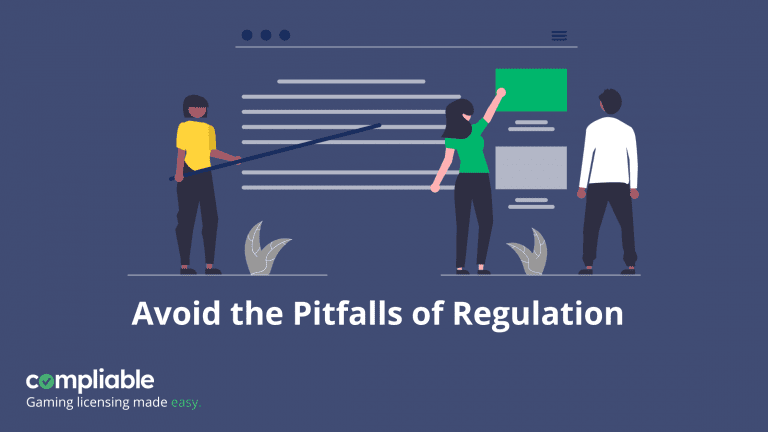
Avoid the Pitfalls of Regulation
Compliable’s Chief Strategy Officer, Justin Stempeck, sat down with EGR to discuss the proliferation of state regulatory portals and the increasing difficulty of managing different technologies across jurisdictions for large operators.
The full report is featured in the EGR North America Quarterly Report. (. Must have a login to access.
EGR: As more states open up, the burden on operators ensuring they are compliant increases, with little reciprocity between regulators. Is this creating unreasonable strain on operators wanting to enter multiple states?
Justin: The state-by-state regulatory structure in the U.S. inherently adds complexity and additional burden to the compliance and licensing department of any online gaming operator active in more than one state. Every state that legalizes and regulates online gaming is doing so in a way that they believe to be reasonable based on their unique priorities. However, it is often the case that the regulators focus on their particular state’s interests fails to account for what a prospective licensee has gone through in other markets.
To date, there has been relatively little codified in regulation that allows for significant reciprocity between states, even when licensing requirements are remarkably similar. The “similar but different” requirements add up as the number of states with legalized online gaming increase, gradually resulting in a significant lift to communicate what is largely the same nucleus of relevant information.
Justin Stempeck, CSO - Compliable Tweet
EGR: Are we already seeing, or can we expect regulators to work together to introduce a common approach to regulatory portals?
Justin: Regulatory portals are an interesting technological development that have appeared to have gained more traction recently. The goal of using technology to make the submission of licensing documents more streamlined and efficient is logical and reasonable; however, the devil is in the detail. Just like the case of licensing requirements that are similar, but not identical, no two regulatory portals are the same. Creating unique regulatory portals, with unique sign in procedures and different ways of entering the same information, creates significant friction for any operator working across multiple states. Clunky user interfaces, non-intuitive instructions and outdated technology often compound the problem. Several portals seem to simply disassemble a traditional licensing form into its component parts forcing users to engage in lengthy data entry exercises to recreate something that could be done in a fraction of the time with the submission of a PDF document.
Some states have implemented helpful portals that expedite the licensing process and are a pleasure to use. However, many regulators, likely in a rush to launch, have adopted existing software solutions not well suited to the task at hand. Portal systems are generally developed by various state contractors with no one company leading the market and thus no expectation of uniformity in portal type or experience is likely.
It is unlikely that we will see regulator consolidation around one portal strategy for the same reason that regulators have different regulations. The only effort at uniformity that had any degree of success in the industry was the adoption of the multi-jurisdictional personal history disclosure form by many gaming states. Unfortunately, this step forward then resulted in a number of steps back when states added unique state supplements to the multi-jurisdictional form.
EGR: What are the biggest hurdles your partners have encountered as they work with regulators across states?
Justin: The systematic management of licensing large cohorts of employees and key individuals across multiple states is an ongoing challenge. From initial licensure to renewal and ongoing reporting of changes that are unique to each state, these are simply some of the requirements for the privilege of holding a gaming license that we do not expect to change. Tracking of this information across any company is difficult, particularly when you layer on different regulatory schema of different states.
While there are myriad tools that purport to help with these problems, choosing the correct tools and using them uniformly is a problem unto itself. For example, forcing HR or payroll software to handle licensing management is jamming a square peg into a round hole, which is rife with risk. Similarly, partial adoption of a solution without sufficient internal communication can also lead to internal gaps where stakeholders are duplicating effort or not even aware of the resources available.
Justin Stempeck, CSO - Compliable Tweet
EGR: How can reg tech, such as the Compliable platform, be used to help operators and regulators alike as the US market matures?
Justin: For operators, reg tech provides a way to efficiently scale across jurisdictions and make compliance staff much more effective. Rather than having to sink in dozens of hours on repetitive administrative tasks such as data entry, staff can regain that time to address the more complex compliance issues that require analysis. Licensing forms that ask for 95% of the same information shouldn’t need to be completed one by one and tools like Compliable automate that work, multiplying an initial effort exponentially.
For regulators, the adoption of a unified standard for the digital submission of licensing data would be a practical step forward into an industry with a significant and growing online presence. When one jurisdiction requires paper forms, another only accepts digital and a third requires using a 25-year-old portal built for another industry it isn’t surprising that errors appear. The time is ripe for industry stakeholders to discuss a unified approach to state regulators (much as they did with the multi-jurisdictional form) which would provide readily available digital data in one format accessible by all.
Click here to view the full EGR North American Quarterly Report





